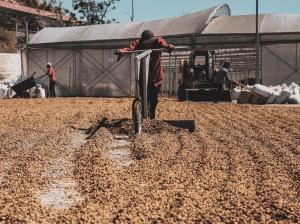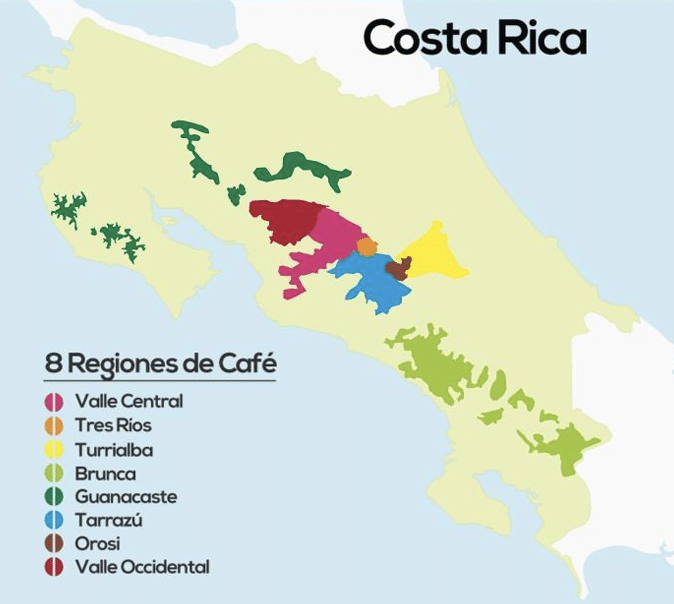COSTA RICA
WHAT TO EXPECT FROM CROP 2022/2023 ?
WHAT TO EXPECT FROM CROP 2022/2023 ?

Costa Rica is known for producing high-quality coffee; it’s the country’s third most important agricultural export after bananas and pineapples.
Coffee production in Costa Rica is largely concentrated in the Central Valley*, where the climate and altitude are ideal for growing coffee. Costa Rica provides around 1% of the world’s coffee production.
According to our local intel, the Costa Rican real estate industry has grown rapidly in recent years. This growth has led to an increased demand for land, including land previously used for coffee plantations. As a result, some coffee plantations in Costa Rica have been sold to real estate developers who plan to develop residential or commercial projects. One factor driving this trend is Costa Rica’s attractiveness as a tourism and retirement destination. This is the main reason why most Costa Rican coffee producers have therefore chosen to create micro-mills and concentrate on specialty coffees.

Each year, our colleagues from our Central American office -based in Guatemala- visit the producers we work with in Costa Rica. This report is from our visit a few weeks ago. So to say ‘hot off the press,’ complete with the latest insights and cool action photos.
Currently, we work with a dozen producers, and they are all delivering exceptional coffees, +86 – Prima category
Some of our producer like Hacienda San Isidro and Finca El Salitre made it to the finalist of Cup of Excellence 2023. This year the auction will take place at the end of June.
GEOPOLITICS
Costa Rica is a small, stable and democratic country. Due to its strategic location between North and South America, Costa Rica has historically been influenced by the geopolitical interests of its larger neighbours, particularly the United States.
The country has a long-standing commitment to peace and disarmament, and has not had a standing army since 1948.
In recent years, Costa Rica has sought to strengthen its economic ties with other countries in the region and around the world.
While Costa Rica is not a major geopolitical player on the world stage, the country’s stable political environment, commitment to democracy and human rights, and strategic location have made it an important player in the region.
Costa Rica has also been a leader in environmental sustainability, with a focus on preserving its natural resources and promoting eco-tourism as a major source of income.

TRADE
According to ICAFE (the country’s coffee institute) Costa Rica exported about 1.1 million 60-kilo bags for the 2021/2022 season.
Costa Rica exported $372M in coffee and the main destination of coffee exports from Costa Rica are: United States ($142M), Belgium ($72.2M), Switzerland ($37.2M), Germany ($22.8M), and South Korea($10.6M).
ICAFE predicts coffee production of approximately 1,365,000 60 kilogram bags in 2022/23. Costa Rica‘s production volume recovers from a 50-year low (in crop year 2021/22) – when higher fungal disease rates exacerbated the impact of a gradual downturn.
Though production volume has slowly declined, the Costa Rican coffee industry has been developing the infrastructure needed to obtain higher prices for smaller lots of better-quality coffee, providing some insulation from fluctuating world coffee prices.

QUALITY
A quick glance at a map reveals that Costa Rica isn’t a very big country, but it does still have a high degree of geographical and climatic diversity. Coffee grown in the rainforest regions can be wildly different from coffee grown in the highlands.
Costa Rican growers are also increasingly distinguishing themselves from other markets by growing more experimental and rare plant varieties, including SL-28, typica, geisha, and even local genetic mutations such as Villa Sarchi and Venesia.
Costa Rica also invented the ‘honey’ processing method, a processing style that’s a sort of mid-way between washed and natural processes. By leaving some mucilage (but not the entire cherry) on the beans while they dry on large patios, farmers can give their beans a rich sweetness boost (among other flavor attributes). These days, honey processing can be found all over Latin America.

COSTA RICAN CROP 2022/2023 WHEREABOUTS
Our selection for the new harvest has been completed and our containers are about to leave Costa Rica.
We are thrilled to receive the new crop from our long-term Costa Rican partners: Finca Las Lajas, Cordillera de Fuego, Hacienda San Isidro, Finca El Salitre.
→ Do you want to receive a sample of the new crop? Contact us to receive the sample of your choice.
KUDO’S, INSPIRATION & REFERENCES
Special thanks to Sébastien Adant (CUPRIMA – Central America) for the intel !
ICAFE – Instituto del Café de Costa Rica
SCA CR – Asociación de Cafés Finos de Costa Rica
MAG CR – Ministerio de Agricultura Costa Rica
USDA Foreign Agricultural Service – Costa Rica Coffee Manuel
CUPRIMA – The Cup of Excellence, Why it Matters?
* Coffee Regions in Costa Rica

CENTRAL VALLEY
Surrounded by San Jose, Heredia and Alajuela, the Central Valley has well defined rainy and dry seasons. The area produces a balanced cup with hints of chocolate and fruit flavors and the subtle smell of honey.
TRES RIOS
Just a few kilometers east of the capital, the lush soil of Tres Rios is enriched by the nearby Irazu Volcano. The result is coffees with a delicately balanced acidity that have earned the region the nickname “the Bordeaux” of Costa Rica.
TURRIALBA
The flavors of this region are heavily influenced by the active Turriabla volcano. Cups sourced here display mild acidity, light body and a soft aroma.
BRUNCA
The humid, tropical climate of the Brunca region give coffees produced here a complex citrus flavor ranging from very mild to incredibly sweet.
GUANACASTE
Found in refreshing, mountainous geography, the beans grown here have a smooth body with light acidity and defined bitter and salty notes.
TARRAZU
The most famous region of Costa Rica is renowned for cups packed with the flavors of chocolate, orange, vanilla and dried fruit.
OROSI
The humid climate paired with lush greenery produces smooth coffees and a balanced cup.
WEST VALLEY
The West Valley enjoys a pleasant climate year round with distinct wet and dry seasons. Flavors from this region vary from organ and peach, to honey and vanilla.